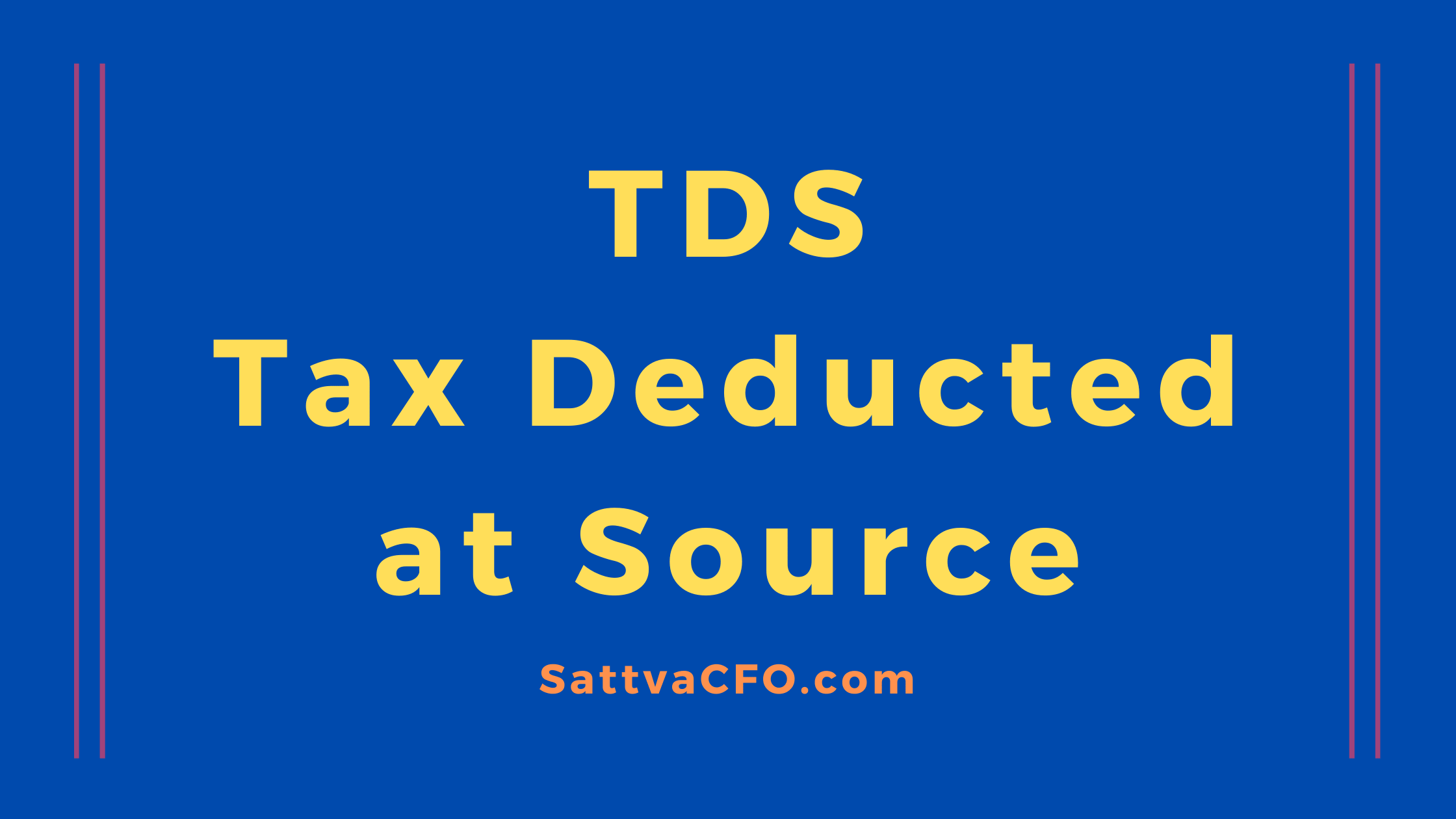Tax Deducted at Source – TDS – One should must know about basics of TDS
Table of Contents
Tax Deducted at Source – TDS
Tax Deducted at Source (‘TDS’) is form of direct taxation. TDS aims to collect tax at source of income. This act as check mechanism for person getting income to disclose income and corresponding tax. TDS – Tax Deducted at Source
The receipt of income is liable to tax on the gross amount even though he gets the net amount after deducting TDS. The amount deducted at sources is adjustable against final tax liability.
In case there is no tax liability or tax liability is lesser than amount deducted. Then, the receipt of income can claim refund of Tax.
Examples of TDS:
Mr A pays professional fees to Mr Z of Rs 100,000/-. TDS is required to be deducted at 10%.
- Mr A should deposit TDS of Rs 10,000/-
- Pay Rs 90,000/- to Mr Z and further TDS of Rs 10,000/- will deposited in PAN of Mr Z. Mr Z may use Rs 10,000/- towards paying his income tax liability.
When should TDS be deducted and by whom?
The person making specified payment is required to ensure deduction of tax at source.
The tax has to be deducted, being earlier of the followings:
- at the time of payment;
- at the time of credit of such income to the account of the payee
What is the due date for depositing the TDS to the government?
The time limit for depositing TDS amount to the account of the Government
- Government: The amount needs to be paid on the same day where the payment is made by or on behalf of the Government
- Other than Government:
- TDS on purchase of property should be deposited within 30 days of the next month ie if property is purchase on 15th July, 202X, then TDS should be deposited within 30th August, 202X. So, tax is paid within 30 days of the next month in which deduction is made.
- Amount paid or credit in March, within next month by 30th April
- Any other case: the amount has to be deposited within the 7th of the next month.
How to deposit TDS?
TDS has to be deposited in Challan No 281: Tax deducted / collected at sources from company deductees / non-company deductees.
What is TDS return?
TDS return is a statement filed by deductor (person making payment and deducting tax) declaring TDS of deductees (recipient of income). TDS return contains of the amount of tax collected and deposit of such tax with government.
This process helps to claim tax credit by deductee.
How and When to file TDS returns?
The person deducting tax has to mandatorily file TDS return. It contains details like TAN of deductor, amount of payment/credit, amount of tax deducted, amount of tax deposited, PAN number of deductee, if available etc.
Details of TDS return forms along with due date of such return is mentioned below
| Form | Type of transaction | Due date for filing return |
|---|---|---|
| 24Q | TDS on Salary | Q1 – 31st July Q2 – 31st October Q3 – 31st January Q4 – 31st May |
| 27Q | TDS on all payment to non-resident except salary | Q1 – 31st July Q2 – 31st October Q3 – 31st January Q4 – 31st May |
| 26QB | TDS on sale of property | 30 days from the end of the month in which TDS is deducted |
| 26QC | TDS on rent | 30 days from the end of the month in which TDS is deducted |
| 26Q | TDS on all payment except salary, non-resident, TDS on rent / sale of property | Q1 – 31st July Q2 – 31st October Q3 – 31st January Q4 – 31st May |
What is a TDS certificate?
TDS certificate is issued by deductor to deductee. It contains the transaction amount and TDS of such amount.
TDS certificate is issued in Form 16, 16A, 16B, 16C
| Form No | Type of transaction | Frequency | Due date |
|---|---|---|---|
| Form-16 | Salary | Yearly | 31st May |
| Form-16A | Other than Salary | Quartely | 15 days from due date of filing return |
| Form-16B | Sale of Property | On each transaction | 15 days from due date of filing return |
| Form-16C | TDS on Rent | On each transaction | 15 days from due date of filing return |
TDS credits in Annual Information Return (AIR) / Form 26AS
Annual Information Return (‘AIR’) earlier known as Form 26AS contains details of income and tax deducted & deposited.
The scope of AIR has been extended considerably with addition for numerous details. New details include specified financial transaction (‘SFT’) containing high value transaction, details of GST returns, tax deposit, tax refund etc.
Consequence of default
Person responsible for deducting taxes has to ensure proper deduction and deposit of tax deducted.
Where the person who is required to deduct TDS, does not deduct or does not pay, or after deducting fails to pay the whole or any part of the tax, then such person shall be deemed to be assessee-in-default in respect of tax.
- Delay in deduction: Interest @ 1% per month for the entire period from the date when liability arises till the actual date tax is deducted.
- Delay in deposit: Interest @1.5% per month for the entire period from the date of deduction of TDS to the actual date of deposit.
Further, there is a penal provision for the non-filing of TDS return in a timely manner.
Consequence if PAN number not furnished
The recipient of income (‘Deductee’) has to furnish his PAN number to person responsible for deducting tax (‘Deductor’). Deductor has to deposit the tax to the Government treasury within stipulated period. If the receipt does not furnish his PAN then tax would be deducted at normal rates or 20% whichever is higher.
TDS statement warning file
TDS Statement warning file is generated if:
1. The value in the Bank Branch Code (BSR code) field of challan in the e-TDS/TCS statements is not present in the authorized list of collecting Bank Branch Codes in the FVU and/or
2. If the PAN of the deductor is same as that of any deductee in the e-TDS/TCS statement.
3. If the challans details of the statement do not match with the details uploaded by the bank.
4. In case tax is deducted at higher rate and corresponding rate of deduction is less than 20%.
5. If date of deduction is beyond the quarter.
6. If TAN name of the deductor is not present in TAN master of Income Tax Department (ITD).
Bank branch code not present in the list of authorized bank branches:
The Bank Branch Code is provided on the challan counterfoil along with the tender date and challan serial no. by the collecting bank branch where TDS / TCS has been deposited.
Deductor / Collector should verify the Bank Branch Code mentioned in the e-TDS/TCS statement with the bank branch code on the challan counterfoil provided by the bank.
In case of mismatch, the bank branch codes as per the challan counterfoil should be mentioned in the e-TDS/TCS statement and the file should be revalidated through FVU.
In case there is no mismatch then the .fvu file created by the FVU should be submitted to the TIN-FC.
Same PAN in deductor and deductee PAN field.
PAN of the deductor given in the deductor details should normally not appear in the deductee details.
Deductor/Collector should verify the PAN in the deductee details and if the same has been correctly entered, then the .fvu file created by the FVU should be submitted to the TIN-FC.
Also read:
- TDS Rate Chart FY 2021-22
- TRACES – Install Emsigner
- Income Tax Slab for FY 2021-22
- Download TAN Allotment
- Depreciation Income Tax
- TRACES – MODIFY / ADD DEDUCTEE DETAILS IN TDS RETURN
- TRACES FAQs–General-TDS
- TDS CHALLAN ITNS 281 – DEPOSIT TDS ONLINE
- NIL TDS Return – Filing declaration of NIL TDS Statement




